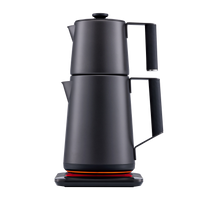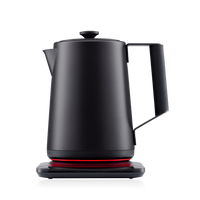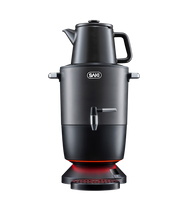exploring turkish coffee beans: selecting and roasting

Summary: Welcome to the comprehensive guide on Turkish coffee. This post explores the details of selecting coffee beans, roasting coffee beans, and achieving the perfect grind. Also introduces the innovative SAKI Electric Turkish Coffee Maker and SAKI's new coffee brand, Kahveji, designed for coffee connoisseurs.
Selecting the Right Beans
The foundation of great cup of coffee lies in the beans. People often prefer a high-quality Arabica variety for its smoother, more aromatic profile. Though the bolder Robusta bean is also a favored choice for those seeking a stronger flavor. Unlike beans used for drip coffee, Turkish coffee beans need a specific flavor profile to create an authentic taste.
Understanding Turkish Coffee Beans
The right Turkish coffee beans, typically of the Arabica variety or sometimes the stronger Robusta bean, are crucial. These beans have a distinctive flavor profile and full-bodied richness.
Arabica Beans: Turkish coffee enthusiasts favor Arabica beans for their mild acidity and subtle taste. Grown at high altitudes, they provide a smooth, aromatic cup with floral and fruity notes. Turkish coffee enthusiasts prefer Arabica beans for their balanced flavor, which suits the unique brewing style.
Robusta Beans: Robusta coffee beans boast bold, earthy flavors and a higher caffeine content. Robusta beans find their place in Turkish coffee for those who prefer a stronger and more robust flavor. These beans are also great for creating a thick, frothy foam.
Green Coffee Beans
Starting with premium green coffee beans is crucial. These unroasted green beans hold the potential for a variety of flavors and strengths. The choice of bean impacts the final taste, whether aiming for a light roasted delicate flavor or a darker roast with deeper intensity.
Turkish Coffee Roasting
Roasting coffee beans requires a delicate balance of temperature and time, transforming the green coffee into aromatic and flavorful coffee roasters. Turkish coffee traditionally uses a medium roast to darker roast, which brings out a rich, full-bodied flavor, perfect for the intense brewing method of Turkish coffee.
The roasting process is critical. It involves precise heating to change the beans' physical and chemical properties, enhancing their flavor and aroma. This process determines whether the coffee will be light, medium, or dark, influencing its body and bitterness. Also this stage helps developing the flavors ranging from sweet and fruity to spicy and nutty, depending on the origin and type of bean.
Mastering Coffee Roasting
Roasting coffee beans for Turkish coffee is an art deeply ingrained in Turkish culture, passed down through generations. Traditional roasting methods involve several key steps:
1. Selection of Green Beans: The process starts with selecting high-quality green coffee beans. These beans typically come from renowned coffee-growing regions like Ethiopia or Brazil.
2. Heating in a Copper Pan: Place the green beans into a specially designed copper pan and heat it over an open flame. Constant stirring ensures uniform roasting.
3. Monitoring and Aroma Assessment: Experienced roasters use their senses during roasting to determine when the beans are ready. They listen for the "first crack," an audible sign that the beans are expanding and releasing moisture. The aroma of the beans plays a crucial role in assessing their readiness.
4. Cooling and Grinding: Once achieving the perfect roast, the beans are swiftly taken off the heat and cooled to prevent over-roasting. After cooling, they are finely ground to a consistency similar to powdered sugar.
Modern Roasting Techniques
While traditional methods hold a special place in Turkish culture, modern roasting techniques have also made their mark. These methods often involve more advanced equipment and precise temperature control:
Drum Roasters: Many modern Turkish coffee roasters use drum roasters, which allow for better control over the roasting process. These roasters offer consistent heat distribution and automated monitoring, ensuring a uniform roast.
Profile Roasting: Profile roasting entails careful managing the temperature and time for roasting beans. Roasters create specific roast profiles to bring out desired flavor characteristics, resulting in a more customizable and consistent product.
Blending: Modern roasters may also experiment with blending different coffee bean varieties to achieve unique flavor profiles. This blending process can lead to a diverse range of Turkish coffee options, catering to varying tastes.
Turkish Coffee Grinding
After roasting, grinding the beans to the right consistency is paramount. Turkish coffee needs an ultra-fine grind, even finer than the one used for espresso. The goal is to create a powder-like consistency allowing for full extraction of flavor. This fine grind is crucial in creating the distinctive thick, rich, and frothy texture of a properly brewed Turkish coffee.
Kahveji: SAKI's New Coffee Brand
SAKI designed Kahveji as their new coffee brand, specifically for Turkish coffee enthusiasts. It offers a selection of beans that are ideal for Turkish coffee. Also emphasizing the unique characteristics needed for the perfect brew.
Saki Electric Turkish Coffee Maker
The SAKI Electric Turkish Coffee Maker brings a modern convenience to this age-old process. It simplifies brewing while maintaining Turkish coffee's authentic taste, now perfectly complemented by SAKI's Kahveji brand.
Complementing Your Coffee with Side Dishes
Complement your Turkish coffee with the perfect side dishes. Sweet Turkish delights and savory snacks enhance the coffee's rich flavors
Conclusion
The perfect Turkish coffee relies on the harmony of the right type of coffee beans, the art of roasting coffee, and fine grinding. Understanding the nuances of dark roasts and medium roasts can elevate your coffee experience. The Saki Electric Turkish Coffee Maker and Kahveji coffee blend tradition with modern ease for authentic Turkish coffee.
Common Questions & Answers
Q: How should Turkish coffee beans be roasted for the best flavor?
A: The medium roast is ideal, offering a balanced flavor. It also enhances the beans' natural sweetness and reduces acidity and bitterness.
Q: Can I use any coffee grinder for Turkish coffee beans?
A: A powder like fine grind, finer than espresso, is crucial. A standard grinder may not work; use a burr grinder with settings for ultra-fine grinding
Q: What is the best way to store Turkish coffee beans to maintain their freshness?
A: Keep ground coffee fresh by storing it in an airtight container in a cool, dark place. Avoid air, light, and moisture to preserve quality. For the freshest taste, buy small amounts and grind just before brewing.
Q: Is there a specific type of coffee bean that is best for Turkish coffee?
A: Traditionally, people prefer Arabica beans because they have a superior flavor and lower acidity compared to Robusta beans.






